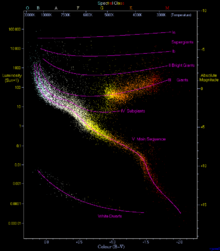HD 108063
This article includes a list of general references, but it lacks sufficient corresponding inline citations. (July 2013) |
| Observation data Epoch J2000.0 Equinox J2000.0 | |
|---|---|
| Constellation | Centaurus |
| Right ascension | 12h 25m 08.52s ± 2.37[1] |
| Declination | −42° 30′ 51.53″ ± 2.11[1] |
| Apparent magnitude (V) | 6.2357 ± 0.006[1] |
| Characteristics | |
| Spectral type | F9.5IV[2][3][note 1] |
| B−V color index | 0.652 ± 0.002[1][note 2][4] |
| Astrometry | |
| Radial velocity (Rv) | 34.48 ± 0.16[5] km/s |
| Proper motion (μ) | RA: -135.25 ± 0.27[1] mas/yr Dec.: -22.55 ± 0.24[1] mas/yr |
| Parallax (π) | 18.53 ± 0.37 mas[1] |
| Distance | 176 ± 4 ly (54 ± 1 pc) |
| Absolute magnitude (MV) | 2.58 ± 0.05[6] |
| Details | |
| Mass | 1.580 ± 0.034[7] M☉ |
| Luminosity | 8.47 ± 0.34 (log 0.9279 ± 0.0173)[7] L☉ |
| Surface gravity (log g) | 4.11 ± 0.12[7] cgs |
| Temperature | 6081 ± 49[7] K |
| Metallicity [Fe/H] | 0.55 ± 0.06[7] dex |
| Rotational velocity (v sin i) | 5.4 ± 1.0[5] km/s |
| Other designations | |
| Database references | |
| SIMBAD | data |
HD 108063 is a star that lies approximately 176 light-years away in the constellation of Centaurus. The star is not particularly noteworthy with exception to its enormously high heavy element content.
Properties[edit]

HD 108063 is a somewhat bright star that lies in an area of the southern sky towards the middle of Centaurus. It has not been studied particularly extensively, but was identified as modestly high proper motion star during the previous century. With a Hipparcos parallax of 18.5 mas, it lies at a distance of 54 parsecs, so the star is fairly nearby. The relative brightness of the star at its distance means that it is substantially over-luminous compared to a dwarf star, and as of such it has been previously classified as a G5III or G4IV star. On the Hertzsprung-Russell diagram (left), the star lies on the subgiant branch, confirming that it is over-luminous. The star's B-V colour indicates a spectral type of F9.5, while the spectroscopic effective temperature indicates a spectral type closer to F9.[2]
Determination of the metallicity of HD 108063 has only been made more recently, with the first value made photometrically in 2004.[8] Their Fe/H of 0.66 dex is slightly higher than the spectroscopic value of Fe/H = 0.55 ± 0.06 dex,[7] which corresponds to a metallicity of 3.54 +0.53
−0.45 times the solar value. This is one of the highest metallicities for any known star, and is identical to 1σ to the Fe/H of HD 126614 (0.56 ± 0.04 dex) and HD 177830 (0.55 ± 0.03 dex).

The enormous metallicity of HD 108063 has strong effect on its apparent parameters. A metal-rich star has a cooler surface temperature than a lower-metallicity star, with the strength of the effect increasing with a higher metallicity. On a plot of B-V (which is an indicator of temperature) to absolute magnitude for main sequence stars (left), HD 108063 has the absolute magnitude of an F0V star but the B-V of an F9-G0V (F9.5V) star, again showing that the star is significantly above the main sequence. However, on a plot of stellar mass to absolute magnitude (left), HD 108063 has parameters consistent with an F0V star. This indicates that the over-luminosity is actually an overly low temperature caused by the star's metallicity and that the apparent subgiant luminosity is artificial. HD 108063 is therefore likely to be on the main sequence.
Notes[edit]
References[edit]
- ^ a b c d e f g h van Leeuwen, F. (2007). "Validation of the new Hipparcos reduction". Astronomy and Astrophysics. 474 (2): 653–664. arXiv:0708.1752. Bibcode:2007A&A...474..653V. doi:10.1051/0004-6361:20078357. S2CID 18759600.
- ^ a b c d A Modern Mean Stellar Color and Effective Temperatures (Teff) # Sequence for O9V-Y0V Dwarf Stars, E. Mamajek, 2011, website/downloadable file. Used for temperatures and B-V values for different spectral types to find the spectral type listed here, and for metallicity-affected parameters if HD 108063 had a solar metallicity.
- ^ a b Luminosity class from position on Hertzsprung-Russell diagram (see image).
- ^ a b Casagrande, L.; et al. (2011). "New constraints on the chemical evolution of the solar neighbourhood and Galactic disc(s). Improved astrophysical parameters for the Geneva-Copenhagen Survey". Astronomy and Astrophysics. 530: A138. arXiv:1103.4651. Bibcode:2011A&A...530A.138C. doi:10.1051/0004-6361/201016276. S2CID 56118016.
- ^ a b c De Medeiros, J. R.; Mayor, M. (1999). "A catalog of rotational and radial velocities for evolved stars". Astronomy and Astrophysics Supplement Series. 139 (3): 433–460. arXiv:astro-ph/0608248. Bibcode:1999A&AS..139..433D. doi:10.1051/aas:1999401.
- ^ a b The relevant calculation for absolute magnitude is , where is the apparent magnitude and is the distance in light-years. The large error compared to the error on observed magnitude is due to the substantial error in distance.
- ^ a b c d e f g Sousa, S. G.; et al. (2011). "Spectroscopic stellar parameters for 582 FGK stars in the HARPS volume-limited sample. Revising the metallicity-planet correlation". Astronomy and Astrophysics. 533: A141. arXiv:1108.5279. Bibcode:2011A&A...533A.141S. doi:10.1051/0004-6361/201117699. S2CID 119273370.
- ^ a b Nordström, B.; et al. (2004). "The Geneva-Copenhagen survey of the Solar neighbourhood: Ages, metallicities, and kinematic properties of 14,000 F and G dwarfs". Astronomy and Astrophysics. 418: 989. arXiv:astro-ph/0405198. Bibcode:2004A&A...418..989N. doi:10.1051/0004-6361:20035959. S2CID 11027621.



